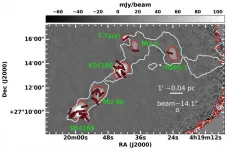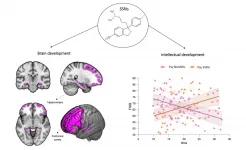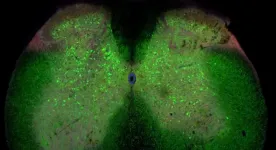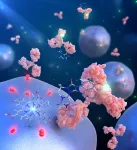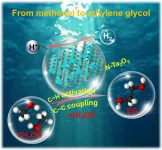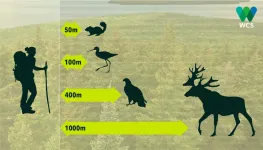INFORMATION:
Study reveals diverse magnetic fields in solar-type star-forming cores
2021-06-01
(Press-News.org) Magnetic fields are ubiquitous throughout our Milky Way Galaxy and play a crucial role in all dynamics of interstellar medium. However, questions like how Solar-type stars form out of magnetized molecular clouds, whether the role of magnetic fields changes at various scales and densities of molecular clouds, and what factors can change the morphology of magnetic fields in low-mass dense cores still remain unclear.
A new study led by Dr. Eswaraiah Chakali from Prof. LI Di's research group at the National Astronomical Observatories of the Chinese Academy of Sciences (NAOC) has partially answered these questions. The study reveals the diverse magnetic field morphologies in Solar-type star forming cores in the Taurus B213 region.
This study was published in The Astrophysical Journal Letters on May 10.
The researchers used high-resolution and sensitive 850-micron dust emission polarization data acquired by the James Clerk Maxwell Telescope (JCMT) using the SCUBA-2 camera along with the POL-2 polarimeter.
The observations were conducted as a part of a large international program called B-fields In STar-forming Region Observations (BISTRO).
"Although formed out of the same filamentary cloud, Taurus/B213, among the three dense cores having more polarization measurements, only one remembers the relatively uniform large-scale magnetic field threading the parental cloud," said Dr. Eswaraiah Chakali, lead author of the study.
This is in contrast to expectations based on the theory that magnetic fields regulate star formation. If a large-scale magnetic field dominates throughout cloud accumulation, core collapse and star formation, the mean position angle of the magnetic field should be similar across various spatial scales.
Further analysis of the gas velocity gradient revealed that the kinematics due to gas accretion flows onto the parental filament could have altered the magnetic field configuration.
"Even in the presence of substantial magnetic flux, local physical conditions can significantly affect magnetic field morphology and their role in star formation," said Prof. LI Di, co-corresponding author of the study.
"Our current observations represent one of the deepest sub-millimeter polarimetry images ever taken using a single dish telescope toward a Galactic region," said Prof. QIU Keping of Nanjing University, co-PI of the BISTRO project and a coauthor of the study.
Prof. LI Di also highlighted "more comprehensive analyses, in combination with Planck data and stellar polarimetry, may give more insights into the evolution of magnetic fields in this stereotypical low-mass star-forming region."
ELSE PRESS RELEASES FROM THIS DATE:
No space wasted: Embedding capacitors into interposers to increase miniaturization
2021-06-01
Scientists at Tokyo Institute of Technology develop a 3D functional interposer--the interface between a chip and the package substrate--containing an embedded capacitor. This compact design saves a lot of package area and greatly reduces the wiring length between the chip's terminals and the capacitor, allowing for less noise and power consumption. Their approach paves the way to new semiconductor package structures with greater miniaturization.
Electronics started big size-wise but have only grown smaller and more compact over time. Today, even smartphones outperform the bulky computers from the 1980s by orders of magnitude. Unfortunately, ...
Curtin study finds WA's natural 'museums of biodiversity' at risk
2021-06-01
Up to three quarters of the biodiversity living on Western Australia's iconic ironstone mountains in the State's Mid West (known as Banded Iron Formations) could be difficult or impossible to return quickly to its previous state after the landscape has been mined, a Curtin University study has found.
The research published in Ecology and Evolution, discovered that the plant ecosystems are well-adapted to the characteristics of the region's ancient and nutrient-poor soils - and that the very different features of mined landscapes mean many native species are unlikely to be returned by rehabilitation.
Lead researcher Dr Adam Cross ...
Protecting the intellectual abilities of people at risk for psychosis
2021-06-01
One person in 2000 suffers from a microdeletion of chromosome 22 that can lead to the development of psychotic disorders, such as schizophrenia, in adolescence. In addition to symptoms such as hallucinations or delusions, psychotic disorders also comes with a progressive decline in intelligence quotient (IQ). If current drug treatments are successful in containing psychotic symptoms, nothing can be done to prevent the deterioration of intellectual skills that leads to loss of autonomy. Researchers at the University of Geneva (UNIGE), Switzerland, have discovered that prescription of selective serotonin reuptake inhibitors (SSRIs) - a class of drugs used to treat anxiety and depression -in late childhood can reduce the deterioration ...
ALS development could be triggered by loss of network connections in the spinal cord
2021-06-01
ALS is a very severe neurodegenerative disease in which nerve cells in the spinal cord controlling muscles and movement slowly die. There is no effective treatment and the average life expectancy after being diagnosed with ALS is usually short. Because of this, new knowledge about the disease is urgently needed.
Now, researchers from the University of Copenhagen have gained new insights about ALS, by investigating the early development of the disease in a mouse model.
"We have found that networks of nerve cells in the spinal cord called inhibitory interneurons lose connection to motor neurons, the nerve ...
A novel nanometer-scale proximity labeling method targeting histidine residues
2021-06-01
Researchers have created a new nanometer-scale proximity labeling system that targets histidine residues quickly, providing a new chemical tool in protein chemical modification.
The results of their research were published in the Journal of the American Chemical Society on April 27, 2021.
Protein chemical modification, a technology that introduces functions into the chemical structure of proteins through irreversible strong bonds, is used for the creation of protein-based biomaterials and for drug delivery systems.
In order to carry out modification, protein labeling is necessary. Proximity labeling is one of those techniques. It labels biomolecules located close to a protein of interest which can then also be marked ...
Solar energy-driven sustainable process for synthesis of ethylene glycol from methanol
2021-06-01
The photochemistry of the future will spring up human industry without smoke, and bring a brighter civilization based on the utilization of solar energy instead of fossil energy. Photochemistry has been used in controlling many reaction processes, especially for the challenging reactions containing selective C-H activation and C-C coupling in chemical synthesis. It is of great interests that a "dream catalytic reaction" of direct coupling of methanol to ethylene glycol (2CH3OH ? HOCH2CH2OH + H2, denoted as MTEG) could be achieved through the solar energy-driven C-H activation and C-C coupling processes, and this MTEG reaction has not been achieved through thermocatalysis yet.
Ethylene glycol (EG) is an important monomer for the manufacture of polymers (e.g., poly(ethylene ...
Safe distance: How to make sure our outdoor activities don't harm wildlife
2021-06-01
Spending time outdoors is good for a person's body and soul, but how good is it for the wildlife around us?
Outdoor recreation has become a popular activity, especially in the midst of a pandemic, where access to indoor activities might be limited. Long known to have negative behavioural and physiological effects on wildlife, outdoor recreation is one of the biggest threats to protected areas. Human disturbance to animal habitats can lower their survival and reproduction rates, and ultimately shrink populations or eradicate them from areas where they would ...
Study pinpoints key causes of ocean circulation change
2021-06-01
Researchers have identified the key factors that influence a vital pattern of ocean currents.
The Atlantic meridional overturning circulation (AMOC) carries warm water from the tropics northward.
Many scientists think that this heat transport makes areas including north-west Europe and the UK warmer than they would otherwise be.
Climate models suggest the AMOC is likely to weaken over the coming decades, with widespread implications for regional and global climate.
The new study - led by the universities of Exeter and Oxford, and published in Nature Geoscience - pinpoints the causes of monthly and annual AMOC variation and finds a differing picture at two key locations.
Observational data came from large ...
Sick bats also employ 'social distancing' which prevents the outbreak of epidemics
2021-06-01
The Covid-19 pandemic has introduced us to expressions like 'lockdown', 'isolation' and 'social distancing', which became part of social conduct all over the world. Now it appears that bats also maintain social distancing which might help prevent the spread of contagious diseases in their colonies. In a new study published in Annals of the New York Academy of Science, researchers from Tel Aviv University demonstrate that sick bats, just like ill humans, prefer to stay away from their communities, probably as a means for recovery, and possibly also as a measure for protecting others. The study was conducted by postdoctoral researcher Dr. Kelsey Moreno and PhD candidate Maya Weinberg ...
Is the U.S. Understating Climate Emissions from Meat and Dairy Production?
2021-06-01
Methane emissions from North American livestock may be routinely undercounted, a new analysis by researchers at New York University and Johns Hopkins University finds. The work also notes that in developing countries, where animal agriculture is becoming increasingly industrialized, methane emissions could rise more than expected.
These assessments are based on a review, appearing in the journal Environmental Research Letters, of eight existing studies.
Methane is a global warming gas even more powerful than CO2. Its amount and lifetime in the atmosphere are smaller than CO2, but quantities are still increasing. The United Nations has recently ...
